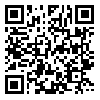Shamsuddin Ahrari 

 , Tahereh Baloochi Beydokhti *
, Tahereh Baloochi Beydokhti * 

 , Moosa Sajadi
, Moosa Sajadi 

 , MohammadReza Mansoorian
, MohammadReza Mansoorian 

 , Ghaderi Mohammad
, Ghaderi Mohammad 




 , Tahereh Baloochi Beydokhti *
, Tahereh Baloochi Beydokhti * 

 , Moosa Sajadi
, Moosa Sajadi 

 , MohammadReza Mansoorian
, MohammadReza Mansoorian 

 , Ghaderi Mohammad
, Ghaderi Mohammad 


Abstract: (53 Views)
Background and Objective: Patients with COVID-19 need education to provide post-discharge care. Determining the learning needs of these patients is one of the essentials for their education. Various factors affect patients' learning needs. One of the things that seems to be related to patients' learning needs is health literacy. This study was conducted with the aim of determining the relationship between learning needs and health literacy of patients with COVID-19.
Methods: The present study is a descriptive correlational study conducted in the year 2021 on 140 patients with COVID-19 hospitalized at Khatam Al-Anbia Hospital in Taybad at the time of hospital discharge. Sampling was performed using a convenience sampling method. Data were collected using a demographic characteristics checklist, standardized questionnaires on patients' learning needs (PLNS), and health literacy (HELIA), and were analyzed using Kolmogorov-Smirnov and Pearson correlation tests, independent t-test, one-way ANOVA, and multiple linear regression at a significance level of p < 0.05 with the assistance of SPSS-20 statistical software.
Findings: The results of this study showed that the mean score of patients' learning needs out of 5 scores with a mean of 3.63±0.57 is relatively high. The most needs are in the dimensions of treatments and complications, medications, and improving the quality of life, and the patients' health literacy score with a mean of 2.12±0.61 is relatively low. There was also a significant inverse relationship between health literacy and the learning needs, meaning that with increasing health literacy, patients' learning needs decreased (p=0.001).
Conclusion:
The results of the study indicate that patients have the most learning needs in the areas of treatment management and its complications, drug use, and improving the quality of life. The findings also indicate an inverse relationship between the level of health literacy and the level of learning needs, so that by promoting health literacy, the need for education in patients decreases. Accordingly, it is recommended that the educational programs of patients focus on these areas of high demand in a targeted manner. Also, the implementation of interventions such as face-to-face education and the use of media capacity are suggested as strategies to promote health literacy and reduce the educational gap.
Methods: The present study is a descriptive correlational study conducted in the year 2021 on 140 patients with COVID-19 hospitalized at Khatam Al-Anbia Hospital in Taybad at the time of hospital discharge. Sampling was performed using a convenience sampling method. Data were collected using a demographic characteristics checklist, standardized questionnaires on patients' learning needs (PLNS), and health literacy (HELIA), and were analyzed using Kolmogorov-Smirnov and Pearson correlation tests, independent t-test, one-way ANOVA, and multiple linear regression at a significance level of p < 0.05 with the assistance of SPSS-20 statistical software.
Findings: The results of this study showed that the mean score of patients' learning needs out of 5 scores with a mean of 3.63±0.57 is relatively high. The most needs are in the dimensions of treatments and complications, medications, and improving the quality of life, and the patients' health literacy score with a mean of 2.12±0.61 is relatively low. There was also a significant inverse relationship between health literacy and the learning needs, meaning that with increasing health literacy, patients' learning needs decreased (p=0.001).
Conclusion:
The results of the study indicate that patients have the most learning needs in the areas of treatment management and its complications, drug use, and improving the quality of life. The findings also indicate an inverse relationship between the level of health literacy and the level of learning needs, so that by promoting health literacy, the need for education in patients decreases. Accordingly, it is recommended that the educational programs of patients focus on these areas of high demand in a targeted manner. Also, the implementation of interventions such as face-to-face education and the use of media capacity are suggested as strategies to promote health literacy and reduce the educational gap.
Type of Study: Research(Original) |
Subject:
Nursing
Send email to the article author
| Rights and permissions | |
 |
This work is licensed under a Creative Commons Attribution-NonCommercial 4.0 International License. |
